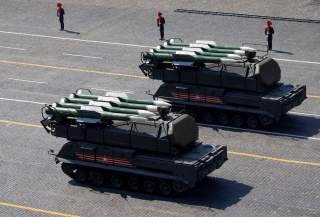Watch Russia Test A New Weapon That Can Kill Missiles
We've got the video.
Key Point: Missile defense might harm the nuclear deterrent.
Russia has tested a new anti-missile interceptor.
Though Russian media hailed the test as an impressive demonstration of Russian military power, it’s not exactly clear why this is so.
Russian television showed a one-minute video of a rocket launch, said to be from the Sary-Shagan test site in Kazakhstan. The video shows a canister—presumably with the missile inside—being transported on a flatbed truck, and then lowered into a pit. The launch, shot from multiple camera angles, shows a rocket rising from a silo so fast that the only thing that can be seen is a streak of flame and a rust-colored cloud of smoke.
Russia’s Ministry of Defense issued a brief announcement. “The air and missile defense forces of the Aerospace Forces successfully conducted a new test launch of a modernized missile of the Russian ABM [anti-ballistic missile] system.”
“After a series of tests, the new ABM system has proved its characteristics and successfully completed the task, engaging the target with a given accuracy,” said Colonel Sergei Grabchuk, commander of the missile unit.
The missile was not identified, with the Ministry of Defense only saying that “the anti-ballistic missile system is in service with the Russian Aerospace Forces. It is designed to protect Moscow from air and space attacks.”
Most likely, it was the PRS-1M. A laudatory 2018 article in Russian news site Gazeta.ru describes it as being part of the A-135 short-range missile defense system. The article refers to the 2017 test of a new missile—an upgrade of the older T6 interceptor—with a detachable rocket-steered warhead.
“In the past, the T6 flew several times faster than a bullet and gained a speed of more than 3 kilometers (1.86 miles) per second in a matter of seconds, being the fastest missile in the world. In the modernized version, its speed was close to four kilometers (2.5 miles) per second.” Gazeta also suggested the PRS-1M could withstand 300 G of force at launch, compared to 200 G for the previous anti-missile interceptor and just 9 G for the old SA-2 anti-aircraft missile.
“In the new product, the height and range of the kill zone increased almost one and a half times,” Gazeta.ru said. “Now the interception of the warheads of the enemy’s intercontinental ballistic missiles is confidently carried out at a height of much more than 50 kilometers (31 miles).”
TV channel Russia 24 proclaimed that “according to military experts, no other country has a similar weapon.”
But that’s not exactly true. During the 1960s, the United States developed the Sprint, a slim, conical missile interceptor that accelerated to Mach 10 and 100 G in five seconds. Popped out of the silo by compressed air, the Sprint would destroy incoming ICBM warheads inside the atmosphere by detonating its own neutron-bomb warhead between 5,000 and 100,000 feet (which also meant a “friendly” nuclear blast over American territory).
Sprint was the low-altitude half of the Safeguard ABM system, which also included longer-range Spartan interceptors to destroy ICBMs in outer space during the exo-atmospheric phase of their trajectory. Safeguard was only deployed on a small scale in the mid-1970s, to protect U.S. ICBM sites. The program was canceled upon the realization that it was much cheaper for an attacker to overwhelm an ABM system with huge numbers of ICBMs and warheads than it was for the defender to build more interceptors.
It’s an issue that still haunts the current U.S. Ballistic Missile Defense System, which is aimed at stopping a handful of primitive North Korean ICBMs, but wouldn’t have a chance against a massed salvo of hundreds of Russian ICBMs. While impressive to watch, Russia’s PRS-1M would still face the same problem of hitting a massive barrage of American warheads descending through the atmosphere at Mach 20.
Michael Peck is a contributing writer for the National Interest. He can be found on Twitter and Facebook. This piece was first featured in June 2019 and is being republished due to reader's interest.
Media: Reuters

